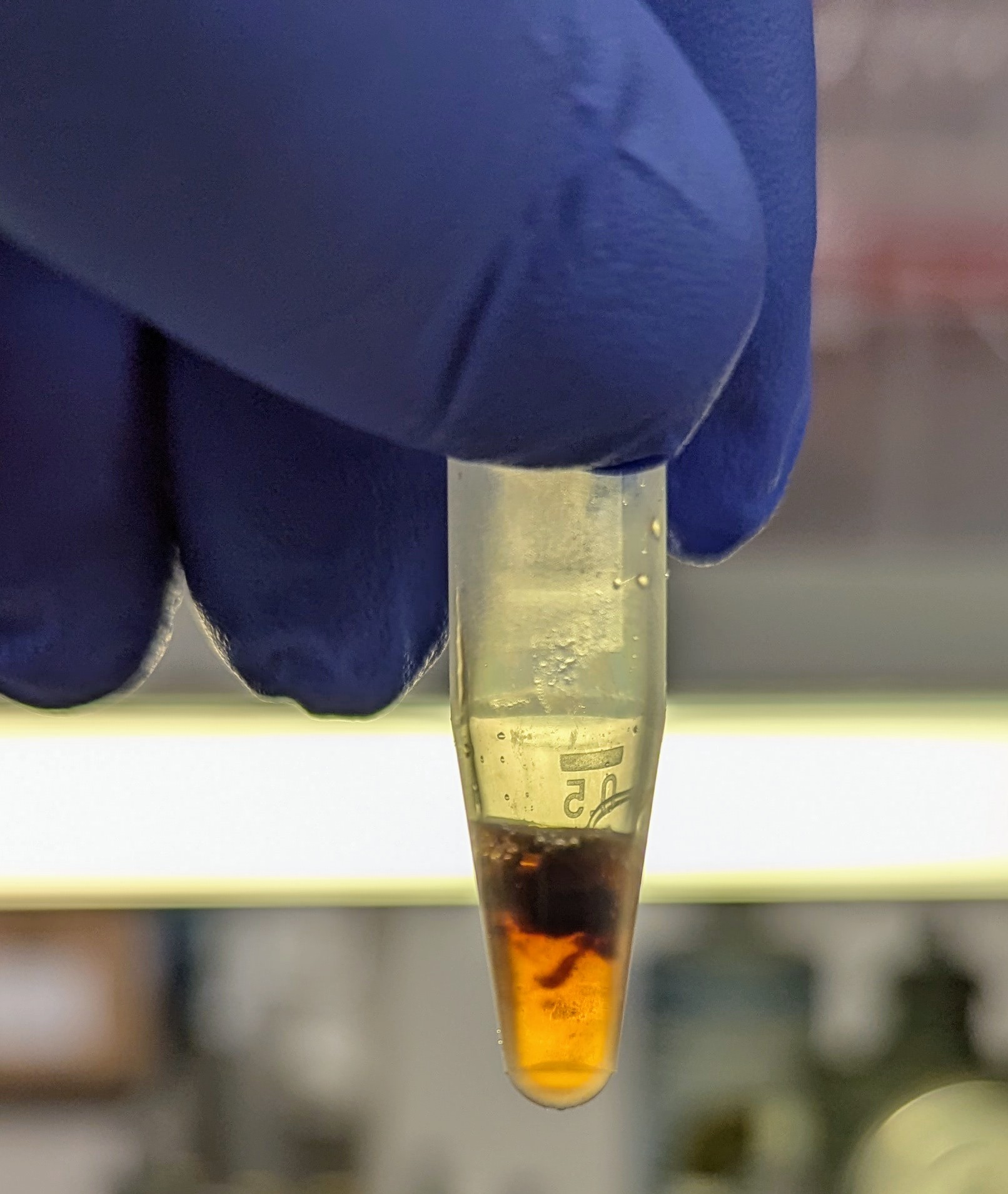INTRO
Previous attempts at co-isolating DNA & RNA from non-heparinized Pacific cod blood had yielded poor results (see 20250325 for a recent example.). I attributed this to the fact that without an anticoagulation agent (e.g. heparin) added at the time of collection, the blood (which had been snap frozen) would immediately coagulate upon the addition of any liquid. This was problematic due to fact that physical homogenization (using disposable plastic mortar/pestle) had little effect on disrupting the gelatinous blood clot in the lysis buffers. Additionally, this gelatinous form prevented lysis buffer and Proteinase K from being able to fully penetrate the mass; thus leading to poor lysis and poor recovery of DNA/RNA.
Serendipitously, I was talking with Emma about this issue and she mentioned she had a disruptor device, similar to a bead beater, called the Bullet Blender. She offered to let me try it out. I selected six samples (see RESULTS for a list of samples) to test this method.
MATERIALS & METHODS
HOMOGENIZATION
Blood samples were thawed on ice and then 200uL of 2x DNA/RNA Shield was added to each and vortexed. The liquid and the gelatinous blood clot were transferred to 1.5mL SafeLock snap cap tubes (Eppendorf). I then added beads in the recommended proportions for the Bullet Blender Fresh Blood protocol. Samples were subjected to two rounds of “blending,” based on sample appearance. Blending was performed in a 4C cold room.
Here is a brief overview of the protocol:
Bead combination:
- 0.5 mm zirconium oxide beads (ZROB05). Use a volume of beads equivalent to 0.25 x the volume of the sample plus
- 0.15 mm zirconium oxide beads (ZROB015). Use a volume of beads equivalent to 0.25 x the volume of the sample
Procedure
1.Place the sample in the tube with the beads. 2. Close the tubes tightly and place them in the Bullet Blender. 3. Set the controls for Speed 10 and Time 3. Press Start. 4. After the run, remove the tubes from the instrument and visually inspect the samples. If homogenization is incomplete, repeat the homogenization step. 5.Proceed with your downstream application.
DNA/RNA Isolation
DNA and RNA isolations were performed using the Quick-DNA/RNA MiniPrep Plus Kit (ZymoResearch).
Protocol was followed with the following notes/changes:
- Did not perform Proteinase K digestion after homogenization.
- RNA was treated with DNase I.
- DNA and RNA were each eluted with 50uL of H2O.
Quantification
DNA was quantified using the Roberts Lab Qubit 3.0 and the 1x High Sensitivity dsDNA Assay (Invitrogen), using 1uL of each sample.
RNA was quantified using Roberts Lab Qubit 3.0 and the RNA High Sensitivity Assay (Invitrogen), using 1uL of each sample.
After the initial DNA quantification, two samples (83B and 86B) had values that were too high and out of range. A 1:5 dilution (1uL sample + 4uL of H2O) was created and these dilutions were quantified the following day.
RESULTS
Homogenization comparison


DNA
Qubit (Google Sheet):
| sample_ID | Concentration(ng/uL) | Volume(uL) | Dilution1 | Total(ng) |
|---|---|---|---|---|
| 82B | 9.66 | 40 | 1 | 386.4 |
| 83B | Out of range | 40 | 1 | #VALUE! |
| 86B | Out of range | 40 | 1 | #VALUE! |
| 88B | 55.8 | 40 | 1 | 2232 |
| 89B | 54.2 | 40 | 1 | 2168 |
| 90B | 67.6 | 40 | 1 | 2704 |
| 83B-1:5-dilution | 40.2 | 40 | 5 | 8040 |
| 86B-1:5-dilution | 60.2 | 40 | 5 | 12040 |
RNA
Qubit (Google Sheet):
| sample_ID | Concentration(ng/uL) | Volume(uL) | Total(ng) |
|---|---|---|---|
| 82B | 5.7 | 40 | 228 |
| 83B | 42 | 40 | 1680 |
| 86B | 47.2 | 40 | 1888 |
| 88B | 24.8 | 40 | 992 |
| 89B | 19.7 | 40 | 788 |
| 90B | 22.4 | 40 | 896 |
SUMMARY
Bullet Blender to the rescue!! Looks like this will be the way to go to get usable quantities of DNA and RNA for sequencing for this project.
Footnotes
A dilution value of
1means the sample was not diluted.↩︎